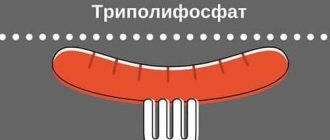| Sodium dihydrogen phosphate | |
| Dihydrogenfosforečnan sodný.JPG | |
| Are common | |
| Systematic name | Sodium dihydrogen phosphate |
| Traditional names | Sodium dihydrogen orthophosphate, sodium phosphate, monosubstituted |
| Chem. formula | NaH2PO4 |
| Physical properties | |
| State | colorless crystals |
| Molar mass | 119.98 g/mol |
| Density | hydr. 1.9096 g/cm³ |
| Thermal properties | |
| T. float. | hydr. 60°C |
| Chemical properties | |
| Solubility in water | 85.220; 207.380 g/100 ml |
| Classification | |
| Reg. CAS number | 7558-80-7 |
| PubChem | 24204 |
| SMILES | [chemapps.stolaf.edu/jmol/jmol.php?model=%5BNa%2B%5D.%5BO-%5DP%28%3DO%29%28O%29O [Na+].[O-]P(=O) (O)O] |
| Data given is based on standard conditions (25 °C, 100 kPa) unless otherwise stated. | |
Sodium dihydrogen phosphate
- an inorganic compound, an acid salt of the alkali metal sodium and orthophosphoric acid with the formula NaH2PO4, colorless crystals, highly soluble in water, forms crystalline hydrates.
Physical properties
Sodium dihydrogen phosphate forms colorless crystals. Well soluble in water, poorly soluble in ethanol.
Forms several crystalline hydrates NaH2PO4• n
H3O, where
n
= 1, 2, which melt in water of crystallization at 100, 60°C, respectively.
Melts of crystalline hydrates, as well as concentrated solutions of sodium dihydrogen phosphate, are viscous, turbid, opalescent liquids that easily crystallize when the temperature drops into a translucent glassy mass.
Sodium phosphates used in the pharmaceutical and food industries
Historically, each of the sodium phosphate compounds has several names, both in Russian and in English. Below are some of the names and chemical formulas of the most common sodium phosphates in medicine and the food industry:
- Na3PO4 is the sodium salt of orthophosphoric acid, also called: sodium orthophosphate; 3-substituted sodium orthophosphate or sodium phosphate (eng. Trisodium phosphate
or
Sodium phosphate tribasic
) - Na3PO4 - sodium phosphate (anhydrous, English anhydrous
) or sodium phosphate 3-substituted (English
Trisodium phosphate (anhydrous)
) - Na3PO4 0.5H2O - sodium phosphate hemihydrate or sodium phosphate 3-substituted 0.5-water (eng. Trisodium phosphate (hemihydrate)
) - Na3PO4 H2O - sodium phosphate monohydrate or sodium phosphate 3-substituted 1-water
- Na3PO4 12H2O - sodium phosphate dodecahydrate or sodium phosphate 3-substituted 12-water (eng. Trisodium phosphate (dodecahydrate)
)
- Na2HPO4 - acidic sodium salt of orthophosphoric acid, other names: sodium hydrogen phosphate, 2-substituted sodium orthophosphate or sodium phosphate, monosubstituted (eng. Disodium phosphate, Disodium hydrogen orthophosphate, Sodium hydrogen phosphate
or
Sodium phosphate dibasic disodium phosphate
) - Na2HPO4 - sodium hydrogen phosphate (anhydrous) or 2-substituted sodium phosphate (eng. Disodium phosphate (anhydrous)
) - Na3PO4 2H2O - sodium hydrogen phosphate dihydrate or sodium phosphate 2-substituted 2-water (eng. Disodium phosphate (dihydrate)
) - Na3PO4 7H2O - sodium hydrogen phosphate heptahydrate or sodium phosphate 2-substituted 7-water (eng. Disodium phosphate (heptahydrate)
) - Na3PO4 12H2O - sodium hydrogen phosphate dodecahydrate or sodium phosphate 2-substituted 12-water (eng. Disodium phosphate (dodecahydrate)
)
or
Sodium dihydrogen phosphate
)
- NaH2PO4 - sodium dihydrogen phosphate (anhydrous) or 1-substituted sodium phosphate (English: Anhydrous monobasic sodium phosphate
,
Monosodium phosphate (anhydrous)
) - NaH2PO4 ·H2O - sodium dihydrogen phosphate monohydrate or sodium phosphate 1-substituted 1-water (eng. Sodium phosphate monobasic monohydrate, Monosodium phosphate (monohydrate)
) - NaH2PO4 2H2O - sodium dihydrogen phosphate dihydrate or sodium phosphate 1-substituted 2-water (eng. Sodium phosphate monobasic dihydrate, Monosodium phosphate (dihydrate)
)
Chemical properties
- Crystalline hydrate loses water when heated in a vacuum:
\mathsf{NaH_2PO_4\cdot 2H_2O \ \xrightarrow{100^oC}\ NaH_2PO_4 + 2H_2O }
- When heated, it forms sodium acid pyrophosphate:
\mathsf{2NaH_2PO_4 \ \xrightarrow{160^oC}\ Na_2H_2P_2O_7 + H_2O }
- or sodium metaphosphate:
\mathsf{NaH_2PO_4 \ \xrightarrow{220-250^oC}\ NaPO_3 + H_2O }
- Reacts with alkalis:
\mathsf{NaH_2PO_4 + NaOH \ \xrightarrow{}\ Na_2HPO_4 + H_2O } \mathsf{NaH_2PO_4 + 2NaOH \ \xrightarrow{}\ Na_3PO_4 + 2H_2O }
- Enters into metabolic reactions:
\mathsf{3NaH_2PO_4 + 3AgNO_3 \ \xrightarrow{}\ Ag_3PO_4\downarrow + 3NaNO_3 + 2H_3PO_4 }
Effect on the body
Harm
The official data that experts have regarding the E 450i additive conclude that the substance is practically unable to cause significant damage to health, since it is used in food production in small concentrations. The maximum dose of the supplement per kg of body weight is allowed in the amount of 70 mg.
There is information that the product can still have a negative effect on the body when used in cosmetic products. When interacting with the skin, sodium diphosphate, which is part of cosmetics, can provoke allergic reactions.
The symptoms are standard, namely: redness appears on the skin, as well as unpleasant itching, small blisters with liquid and swelling. Such negative manifestations can last for several days.
Excerpt describing Sodium Dihydrogen Phosphate
Prince Andrei lived in the village for two years without a break. All those enterprises on estates that Pierre started and did not bring to any result, constantly moving from one thing to another, all these enterprises, without showing them to anyone and without noticeable labor, were carried out by Prince Andrei. He had, to a high degree, that practical tenacity that Pierre lacked, which, without scope or effort on his part, set things in motion. One of his estates of three hundred peasant souls was transferred to free cultivators (this was one of the first examples in Russia); in others, corvee was replaced by quitrent. In Bogucharovo, a learned grandmother was written out to his account to help mothers in labor, and for a salary the priest taught the children of peasants and courtyard servants to read and write. Prince Andrei spent half of his time in Bald Mountains with his father and son, who was still with the nannies; the other half of the time in the Bogucharov monastery, as his father called his village. Despite the indifference he showed Pierre to all the external events of the world, he diligently followed them, received many books, and to his surprise he noticed when fresh people came to him or his father from St. Petersburg, from the very whirlpool of life, that these people, in knowledge of everything that is happening in foreign and domestic policy, they are far behind him, who sits in the village all the time. In addition to classes on names, in addition to general reading of a wide variety of books, Prince Andrei was at this time engaged in a critical analysis of our last two unfortunate campaigns and drawing up a project to change our military regulations and regulations. In the spring of 1809, Prince Andrei went to the Ryazan estates of his son, whom he was guardian. Warmed by the spring sun, he sat in the stroller, looking at the first grass, the first birch leaves and the first clouds of white spring clouds scattering across the bright blue sky. He didn’t think about anything, but looked around cheerfully and meaninglessly. We passed the carriage on which he had spoken with Pierre a year ago. We drove through a dirty village, threshing floors, greenery, a descent with remaining snow near the bridge, an ascent through washed-out clay, stripes of stubble and green bushes here and there, and entered a birch forest on both sides of the road. It was almost hot in the forest; you couldn’t hear the wind. The birch tree, all covered with green sticky leaves, did not move, and from under last year’s leaves, lifting them, the first green grass and purple flowers crawled out. The small spruce trees scattered here and there throughout the birch forest with their coarse, eternal greenness were an unpleasant reminder of winter. The horses snorted as they rode into the forest and began to fog up. The footman Peter said something to the coachman, the coachman answered in the affirmative. But apparently Peter had little sympathy for the coachman: he turned on the box to the master. - Your Excellency, how easy it is! – he said, smiling respectfully. - What! - Easy, your Excellency. "What he says?" thought Prince Andrei. “Yes, that’s right about spring,” he thought, looking around. And everything is already green... how soon! And the birch, and the bird cherry, and the alder are already starting... But the oak is not noticeable. Yes, here it is, the oak tree.” There was an oak tree on the edge of the road. Probably ten times older than the birches that made up the forest, it was ten times thicker and twice as tall as each birch. It was a huge oak tree, two girths wide, with branches that had been broken off for a long time and with broken bark overgrown with old sores. With his huge, clumsy, asymmetrically splayed, gnarled hands and fingers, he stood like an old, angry and contemptuous freak between the smiling birches. Only he alone did not want to submit to the charm of spring and did not want to see either spring or the sun. “Spring, and love, and happiness!” - as if this oak tree was saying, - “and how can you not get tired of the same stupid and senseless deception. Everything is the same, and everything is a lie! There is no spring, no sun, no happiness. Look, there are the crushed dead spruce trees sitting, always the same, and there I am, spreading out my broken, skinned fingers, wherever they grew - from the back, from the sides; As we grew up, I still stand, and I don’t believe your hopes and deceptions.” Prince Andrei looked back at this oak tree several times while driving through the forest, as if he was expecting something from it. There were flowers and grass under the oak tree, but he still stood in the midst of them, frowning, motionless, ugly and stubborn. “Yes, he is right, this oak tree is a thousand times right,” thought Prince Andrei, let others, young people, again succumb to this deception, but we know life - our life is over! A whole new series of hopeless, but sadly pleasant thoughts in connection with this oak tree arose in the soul of Prince Andrei. During this journey, he seemed to think over his whole life again, and came to the same old reassuring and hopeless conclusion that he did not need to start anything, that he should live out his life without doing evil, without worrying and without wanting anything.
What is pyrophosphate
Pyrophosphate is a salt of pyrophosphoric acid or an ester. The formula of pyrophosphate has the form: P2O7.
First of all, pyrophosphates slow down the “aging” of foods and food dyes and improve the consistency of the product. They also stabilize oxidation processes. To all this you can add bactericidal and antioxidant effects. Therefore, they are widely used for preserving meat and preparing dairy products.
Moreover, frequent consumption of pyrophosphates can change the balance between calcium and phosphorus. Therefore, if calcium is poorly absorbed, the result may be its deposition in the kidneys.
And then this process, if not stopped, will lead to the development of osteoporosis in the body.
And above all, you need to be very careful about phosphate-containing foods if your diet contains large amounts of phosphorus.
Classification of pyrophosphates
In the food industry there are 9 classes of pyrophosphate:
| code | Pyrophosphate |
| E450I | Sodium diphosphate |
| E450II | Trisodium diphosphate |
| E450III | Tetrasodium diphosphate |
| E450IV | Potassium diphosphate |
| E450V | Tetrapotassium diphosphate |
| E450VI | Dicalcium diphosphate |
| E450VII | Calcium diphosphate acid |
| E450VIII | Dimagnesium diphosphate |
| E450IX | Magnesium diphosphate |
Harmful and negative effects of E450
- The first, but not the only part of the body that suffers from the effects of the E 450 stabilizer is the musculoskeletal system.
- The cardiovascular system also fully feels the negative impact of this dietary supplement. For example, recent studies have shown increased levels of phosphate in the walls of blood vessels. Therefore, if this supplement is always present in your diet, cholesterol plaques may appear in the lumen of the blood vessels.
- This can be potentially harmful as it is a risk factor for cardiovascular disease, especially in the case of kidney failure.
- Risk of developing diabetes. Because calcium is necessary for the rhythmic contraction and relaxation of the heart muscle. In case of shortage, the heart quickly wears out. It should also be noted that calcium is needed to produce insulin.
- In addition to the formation of kidney stones, there are problems with the musculoskeletal system. As you can see, treating osteoporosis is a very long and labor-intensive process.
- In 2022, the WHO reassessed the safety associated with phosphate intake as supplements and through food in general.
- A new ADI, more stringent than the previous one, has been established for all levels of phosphate consumption. Those coming from dietary supplements can account for 6 to 30% of total phosphate intake.
- Therefore, estimated exposure levels are likely to exceed the ADI for children and adolescents who are regular consumers of foods containing them.
- In addition, the established ADI does not include individuals with moderate to severe renal impairment.
E450 is a carcinogen, so its use significantly increases the risk of malignant neoplasms.
- As a reminder, phosphate additives are licensed for over 100 food products.
- The categories that most impact consumer exposure through additives are primarily bakery and confectionery products. As well as industrial cheeses and even meat products.
Is it approved by organic cosmetics standards?
First of all, let's take a look at the COSMOS standard (Version 3.0 - dated January 1, 2022, website: a7e08fa4-7e84-472f-86dd-95a19f777744.filesusr.com/ugd/0bbe4a_027bbe23336149a4aba6071eb65f2ae5.pdf).
The COSMOS standard divides all ingredients used in cosmetics into 5 categories, and each of them has specific requirements. In Annex IV, which deals with ingredients of mineral origin, there are no pyrophosphates or diphosphates in the list of permitted ingredients. However, the document states that phosphates of mineral origin can be used, in addition to those already on the list, as buffers, chelators and anti-caking agents if there is no alternative.
To dispel all doubts about whether tetrapyrophosphate is approved according to the COSMOS standard or not, go to the website: cosmos-standard-rm.org, which contains a list of inorganic raw materials approved for use in cosmetic products certified according to the COSMOS standard.
Among the list of all ingredients we find TSPP, Tetrasodium Pyrophosphate, produced by Budenheim, an international company with many years of experience in the production of highly purified phosphates and phosphate complexes for various areas of the food industry.
Thus, it turns out that the COSMOS standard approves sodium tetrapyrophosphate.
Let's check other eco-labels. Alginate masks from the PuroBio brand also contain pyrophosphate. Despite this, the mask bears the eco-label of the CCPB , an international certifying body for organic cosmetics founded in 1995.
CCPB is the first Italian certification body recognized by NATRUE (www.natrue.org). This means that the CCPB is officially authorized to certify ingredients and finished products according to the NATRUE labeling criteria (www.natrue.org/our-standard/natrue-approved-certifiers-nacs/).
In the CCPB cosmetic standard (www.ccpb.it/en/blog/certificazione/organic-cosmetics/) for both natural and organic cosmetics, this ingredient is included in the list of permitted ingredients of natural origin.
ICADA , which issues an organic certificate only to professional cosmetics brands, also approves this ingredient in alginate masks. Products with this marking can be found from the SATIVA brand.
And yet, I would like to separately note that the concentration of the chemical element in the finished product is IMPORTANT. The manufacturer is not required to indicate the ratio of ingredients; we do not know for sure what dose is contained in the finished product.
If you are still in doubt, pay attention to masks without this component. For example, the company Spivak : the price of 40 g of powder varies from 160 to 190 rubles. The composition of alginate masks does not contain sodium pyrophosphate. You can be sure that this ingredient will not harm your skin in any way, but! as it became clear from the article and can be found in some reviews: you will need additional skill to evenly dilute the powder and remove the mask. The composition also contains essential oils, so we strongly advise you to test for individual intolerance.
Areas of use
Where are pyrophosphates used? The main applications of sodium salts are the food, chemical, textile, and production of household chemicals and cosmetics. E450 is part of the following groups and products:
- detergents with antibacterial effect;
- in paint and varnish or anti-corrosion coatings;
- detergents;
- liquids for removing scale and rust;
- serves as an agent in fabric bleaching;
- in toothpastes, creams, powders.






